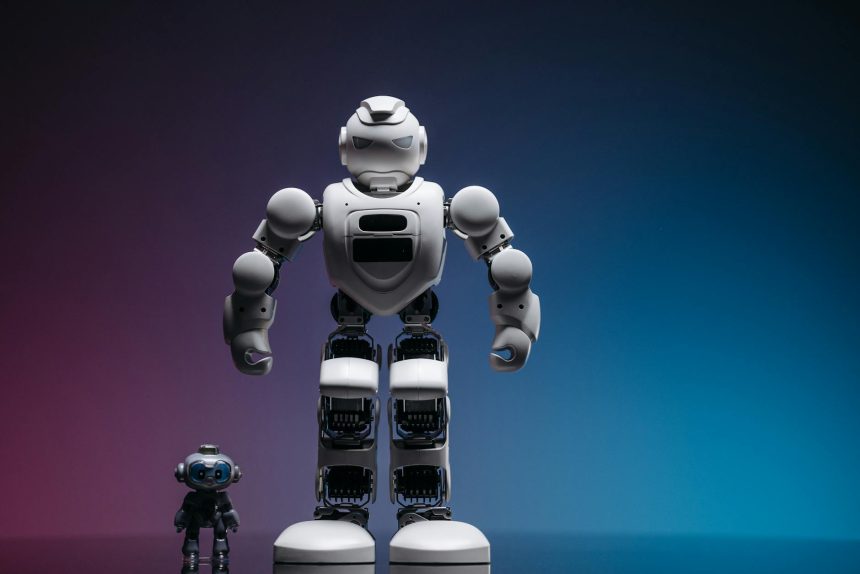## Outline
The Dawn of Autonomous Builders: Robotics in Construction
Robots on the Rise: A New Era for Building
The construction sector, long a bastion of human labor, is on the cusp of a technological revolution. While still in nascent stages, advanced robotics, particularly humanoid robots, are poised to redefine how we build, promising enhanced efficiency, safety, and precision. This shift isn’t just a distant dream; it’s a tangible future that industry leaders must prepare for.
Why Robotics in Construction? Addressing Industry Challenges
The Labor Shortage Conundrum
One of the most pressing issues facing the construction industry today is a persistent and growing labor shortage. Finding skilled workers is becoming increasingly difficult, leading to project delays and escalating costs. Robotics offers a potential solution by augmenting human capabilities and taking over repetitive or dangerous tasks.
Safety First: Mitigating Construction Site Risks
Construction sites are inherently hazardous environments. Falls, heavy machinery accidents, and exposure to dangerous materials are common concerns. Autonomous systems, including humanoid robots, can operate in high-risk zones, significantly reducing the likelihood of human injury and improving overall site safety protocols.
Boosting Productivity and Precision
Robots can perform tasks with unparalleled consistency and accuracy, 24/7. This continuous operation, free from fatigue, can dramatically increase project timelines and improve the quality of the final build. From laying bricks to welding complex structures, their precision is a game-changer.
The Emerging Landscape of Construction Robots
Current Capabilities and Pilot Programs
Today’s construction robots are moving beyond simple automation. We’re seeing intelligent machines capable of:
- Autonomous bricklaying
- Robotic welding and cutting
- Site surveying and mapping
- Material handling and transport
- 3D printing of building components
Many of these technologies are currently in pilot phases, demonstrating their feasibility and potential impact on real-world projects. These early successes are paving the way for wider adoption.
Humanoid Robots: The Next Frontier
Humanoid robots, with their ability to mimic human movement and dexterity, hold particular promise. Their form factor allows them to navigate existing site layouts and operate tools designed for human hands. Imagine robots that can:
- Ascend scaffolding
- Operate power tools with precision
- Perform intricate assembly tasks
- Collaborate with human workers
This level of adaptability makes them ideal candidates for a wide range of construction applications.
Preparing for the Automated Future of Building
Upskilling the Workforce
The integration of robots doesn’t necessarily mean job displacement. Instead, it necessitates a shift towards new skill sets. The workforce will need training in operating, maintaining, and supervising these advanced machines. This creates opportunities for new roles and career paths within the sector.
Strategic Investment and Integration
Companies must begin to strategically assess where robotics can offer the most significant benefits. This involves understanding the technology’s limitations, identifying suitable pilot projects, and planning for phased integration. Early adopters will likely gain a significant competitive advantage.
Ethical and Regulatory Considerations
As robotics become more prevalent, ethical questions surrounding data privacy, job security, and the responsible deployment of AI will arise. Proactive engagement with regulatory bodies and the development of industry-wide standards will be crucial for a smooth transition.
Conclusion: Building Tomorrow, Today
The integration of robotics, especially humanoid robots, into the construction industry is not a question of ‘if,’ but ‘when.’ By understanding the challenges, exploring current capabilities, and strategically preparing for this technological evolution, leaders can ensure their organizations are at the forefront of building the future.
## Suggested URL Slug
`robots-in-construction`
## SEO Title
`Robots in Construction: Building Tomorrow’s Future`
## Full Article Body
The Dawn of Autonomous Builders: Robotics in Construction
Robots on the Rise: A New Era for Building
The construction sector, long a bastion of human labor, is on the cusp of a technological revolution. While still in nascent stages, advanced robotics, particularly humanoid robots, are poised to redefine how we build, promising enhanced efficiency, safety, and precision. This shift isn’t just a distant dream; it’s a tangible future that industry leaders must prepare for.
Why Robotics in Construction? Addressing Industry Challenges
The Labor Shortage Conundrum
One of the most pressing issues facing the construction industry today is a persistent and growing labor shortage. Finding skilled workers is becoming increasingly difficult, leading to project delays and escalating costs. Robotics offers a potential solution by augmenting human capabilities and taking over repetitive or dangerous tasks.
Safety First: Mitigating Construction Site Risks
Construction sites are inherently hazardous environments. Falls, heavy machinery accidents, and exposure to dangerous materials are common concerns. Autonomous systems, including humanoid robots, can operate in high-risk zones, significantly reducing the likelihood of human injury and improving overall site safety protocols.
Boosting Productivity and Precision
Robots can perform tasks with unparalleled consistency and accuracy, 24/7. This continuous operation, free from fatigue, can dramatically increase project timelines and improve the quality of the final build. From laying bricks to welding complex structures, their precision is a game-changer.
The Emerging Landscape of Construction Robots
Current Capabilities and Pilot Programs
Today’s construction robots are moving beyond simple automation. We’re seeing intelligent machines capable of:
- Autonomous bricklaying
- Robotic welding and cutting
- Site surveying and mapping
- Material handling and transport
- 3D printing of building components
Many of these technologies are currently in pilot phases, demonstrating their feasibility and potential impact on real-world projects. These early successes are paving the way for wider adoption. For more on the cutting edge of automation, explore advancements in robotics and automation.
Humanoid Robots: The Next Frontier
Humanoid robots, with their ability to mimic human movement and dexterity, hold particular promise. Their form factor allows them to navigate existing site layouts and operate tools designed for human hands. Imagine robots that can:
- Ascend scaffolding
- Operate power tools with precision
- Perform intricate assembly tasks
- Collaborate with human workers
This level of adaptability makes them ideal candidates for a wide range of construction applications. Their potential for integration is further explored in discussions about the future of robotics and automation.
Preparing for the Automated Future of Building
Upskilling the Workforce
The integration of robots doesn’t necessarily mean job displacement. Instead, it necessitates a shift towards new skill sets. The workforce will need training in operating, maintaining, and supervising these advanced machines. This creates opportunities for new roles and career paths within the sector.
Strategic Investment and Integration
Companies must begin to strategically assess where robotics can offer the most significant benefits. This involves understanding the technology’s limitations, identifying suitable pilot projects, and planning for phased integration. Early adopters will likely gain a significant competitive advantage.
Ethical and Regulatory Considerations
As robotics become more prevalent, ethical questions surrounding data privacy, job security, and the responsible deployment of AI will arise. Proactive engagement with regulatory bodies and the development of industry-wide standards will be crucial for a smooth transition.
Conclusion: Building Tomorrow, Today
The integration of robotics, especially humanoid robots, into the construction industry is not a question of ‘if,’ but ‘when.’ By understanding the challenges, exploring current capabilities, and strategically preparing for this technological evolution, leaders can ensure their organizations are at the forefront of building the future.
## Excerpt
The construction industry is on the brink of a major transformation with the rise of robotics. Discover how humanoid robots and autonomous systems are addressing labor shortages, enhancing safety, and boosting productivity, and learn how leaders can prepare for this exciting future.
## Image Search Value for Featured Image
“Humanoid robot working on a construction site, futuristic building, advanced technology, safety equipment”
Featured image provided by Pexels — photo by Pavel Danilyuk








